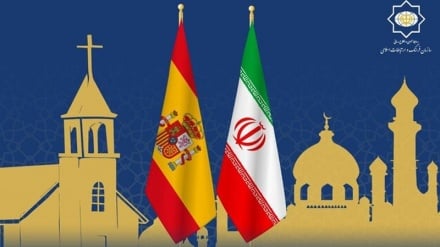Sunni Muslims' view about Imam Mahdi, Savior of end time and its similarities with Shia view
-

Sunni Muslims\' view about Imam Mahdi, Savior of end time and its similarities with Shia view
Pars Today - The number of narrations which have been mentioned on Imam Mahdi by Sunni Muslims has reached one hundred and all these narrations point to the reappearance of Imam Mahdi.
The belief in Mahdaviat (reappearance of Imam Mahdi as the Awaited Savior of mankind) and the idea of Imam Mahdi's reappearance is considered as an important part of the Islamic ideology which has been shaped among all Islamic sects and denominations on the basis of the Prophetic good tidings. In this article, Pars Today has cast a look at the view of Sunni Muslims on the Redeemer of the end time, Imam Mahdi, and the similarities of this view with that of the Shia Muslims.
The narrations related to Imam Mahdi (May God hasten his reappearance) have been mentioned in many famous books of Sunni and Shia Muslims; and with a close look at these narrations, we see that there are a lot of commonalities between Sunni and Shia sects with regards to Imam Mahdi. These commonalities include certainty of the reappearance and uprising of Imam Mahdi, Imam Mahdi's genealogy, his physical features, the backgrounds of reappearance, the signs of reappearance, the affairs related to Imam Mahdi, his being namesake of the Prophet, the characteristics of his rule and so on.
Furthermore, examining the narrations and hadith shows that there are also differences between the Shia and Sunni views on Mahdaviat such as the difference in Imam Mahdi's birth, the difference in Imam Mahdi's being in occultation and the difference in his infallibility.
The number of narrations about Imam Mahdi, which have been frequently mentioned in view of Sunni Muslims, amount to one hundred and all these narrations point to the reappearance of Imam Mahdi. According to valid texts of Sunni Muslims, some 20 companions of Prophet Mohammad (Blessings of Allah upon him and his progeny) have narrated hadith on Imam Mahdi all of which can be seen in famous Islamic sources and major texts of hadith including Sunan, Ma'ajem and Masanid such as: Sunan Abu Dawud, Sunan Termezi, Sunan Ibn Majeh, Musnad Ahmad, Sahih Hakem, Bazzaz and Mo'jam Tabarani.
A survey of the sources and words of Sunni scholars makes it clear that Imam Mahdi is one of the descendants of Lady Fatimah (Peace upon her) and will reappear.
Sunni scholars' statements on reappearance
As for the reappearance of the Reformer of the end time, there has been no difference among the companions and the companions of companions [of Prophet] since the first century AH till now; and all (Sunni scholars) unanimously believe in the reappearance and if anyone had doubted the accuracy of narrations and issuance of this good tiding of the Prophet of Islam, everyone would have considered it as his lack of determination or knowledge. Thus, no one has rejected the claimers of Mahdaviat with denial of the principle of reappearance of Imam Mahdi.
In view of this, Suwaidi says, "What everyone agrees unanimously is that Mahdi is the one who will stage an uprising in the end time and will fill the earth with justice."
Kheiruddin Alousi, another Sunni scholar, says, "According to the most correct statements among most thinkers, the reappearance of Mahdi is among the signs of Resurrection and the opinion of some people who have denied his coming, is devoid of value and credit."
Sheikh Mohammad Iravani writes in his book, al-Imam al-Mahdi, "As far as I know, Sunni Muslims have authored more than 30 books in this regard. (Iravani, Mohammad Baqer, al-Imam al-Mahdi, p11)
Some Sunni narrators of hadith
- Ibn Sa'ad (died 230 AH)
- Ibn Abi Shaiba (died 235 AH)
- Ahmad ibn Hanbal (died 241 AH)
- Bukhari (died 273 AH)
- Moslem (died 261 AH)
- Ibn Majeh (died 273 AH)
- Abu Bakr Eskafi (died 273 AH)
- Termezi (died 279 AH)
- Tabari (died 380 AH)
- Ibn Qutaiba Dinvari (died 276 AH)
- Hakem Neishaburi (died 405 AH)
- Beihaqi (died 485 AH)
- Khatib Baghdadi (died 463 AH)
- Ibn Kathir Jazari (died 606 AH)
(Source: al-Mahdi al-Muntazar fil-Fikr al-Islami)
Ibn Kathir, also, writes in al-Bidaya wal-Nihaya, "Mahdi comes in the end time and fills the earth with fairness and justice as it has been filled with oppression and injustice. We have mentioned the narrations related to Mahdi in a separate volume just as Abu Dawud has dedicated a separate book to it in his Sunan." (Ibn Kathir, Esmail ibn Umar, al-Bidaya wal-Nihaya, v6, p248)
Some commonalities between Shias and Sunnis
Some of the commonalities of Shia and Sunni sects pertaining to Imam Mahdi (Imam of the age) (May God hasten his reappearance) are mentioned here:
- Imam Mahdi's reappearance and his global rule is a definite issue and all Islamic sects are united on it.
- Imam Mahdi will rise up with the aim of establishing justice and monotheism in the world.
- Imam Mahdi will fight oppression.
- The Prophet has strongly emphasized on Imam Mahdi.
- Imam Mahdi (May God hasten his reappearance) is from the Ahl al-Bayt (Peace upon them) and one of the descendants of the Messenger of God. Ibn Majeh has narrated in his Sunan that the Prophet (Blessings of Allah upon him and his progeny) said, "Al-Mahdi is from us Ahl al-Bayt. God will make the preparations for him (his uprising) within a night." (Ibn Majeh, Mohammad ibn Yazid, Sunan Ibn Majeh, v2, p1367, hadith 4085)
- Imam Mahdi is from the progeny of Lady Fatimah and Imam Ali, the testamentary legatee of the Prophet of Islam. Suyuti has narrated in Urf al-Wardi that the Messenger of God took Imam Ali's hand and said, "A youth will come out of this man's progeny who will fill the earth with fairness and justice." (Suyuti, Jalal-ul-din, Urf al-Wardi, p100). Ibn Majeh has also narrated from Omm Salameh that she had heard the Messenger of God saying, "Al-Mahdi is from the progeny of Fatimah." (Ibn Majeh, Mohammad ibn Yazid, Sunan Ibn Majeh, v2, p1368, hadith 4086)
Common descriptions of Imam Mahdi's apparent features
The characteristics mentioned in the books of Sunni scholars about Imam Mahdi have been adopted from the narrations that they narrate from the Prophet of Islam (Blessings of Allah upon him and his progeny) and they are not different, in general, with the characteristics mentioned in the books of Shia scholars. They include characteristics such as: Imam Mahdi's being powerful at the time of reappearance, his brilliant face, his long forehead, his thin nose, a mole on his chin, his reappearance as a 40-year-old man, his being namesake of the Prophet. (Sources: Faraed al-Samtain, al-Musannaf, al-Bayan fi Akbar al-Zaman, Eqd al-Farid)
RM/MG
Key phrases: Who is Imam Mahdi? Mahdaviat, Mahdi in Shiism and Sunnism, Sunni Muslims' view on Imam Mahdi


